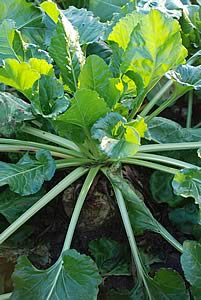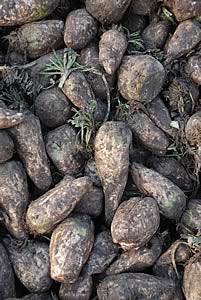 |
|||||||||
|
|||||||||||||||||||
|
|
New Trilogy Herbicide for Fodder Beet Weed Control 2010-02-11 A new herbicide option designed specifically to help fodder beet growers simplify the often-complex process of weed control, while also boosting the level of overall control and yield, is being launched for 2010.
Trilogy, from United Phosphorous, is for post-emergence use soon after weeds germinate and works by targeting weeds with three different active ingredients, says the company’s UK sales manager, Richard Allen. But more than that, it also treats weeds with a robust overall dose of active ingredient, he says, yet its specially-developed formulation shows a high degree of safety to the crop. “As livestock producers look more towards home-produced feed, fodder beet is a traditional crop which has swung back into favour,” explains Mr Allen. “Weeds are a major cause of yield loss, but present a dilemma for control. “For a start, fodder beet is highly susceptible to weed competition during its critical establishment phase, but weeds germinate in multiple flushes and are often much faster-growing. Also, fodder beet can be very sensitive to herbicides, yet the weeds which compete with it are not easy to control with gentle sprays. “For these reasons, a programme of several low dose herbicide sprays at the start of the season is frequently used - beginning with a soil-acting, pre-emergence herbicide, and followed by repeat sprays of different post-emergence herbicides, often mixed together, and often applied three or so times at weekly intervals as each subsequent weed flush appears. “In launching Trilogy as a post-emergence treatment we have tried to make this process simpler - by providing a product which already combines three different active ingredients, designed to give a higher level of weed control, cover a broader range of weeds, and ultimately give improved yield.“
According to Mr Allen, the three active ingredients contained in Trilogy - contact-acting phenmedipham and desmedipham, and residual ethofumesate which remains active in the soil for several weeks - each covers a different weed spectrum. This may not eliminate the need to mix herbicides with it completely, but should certainly help reduce the amount of total mixing, he notes. “In addition, its specially-developed structured surfactant formulation (SSF) it is also gentle on the crop. “This crop safety, in turn, allows it to be formulated so that 22% more active ingredient is applied when used at the recommended rate - which, in turn, contributes to a further level of weed control activity,” he adds. “It is this combination of achieving higher levels of weed control in a crop-safe way which helps the crop grow away to achieve high yields.” In trial plots, the three-way combination of active ingredients in Trilogy gave around a 15% increase in weed control over an alternative treatment from one application, Mr Allen points out. “The weed spectrum of Trilogy includes annual meadow grass, black bindweed, chickweed, fat hen, forget-me-not, field pansy, field pennycress, ivy-leaved speedwell, knotgrass, shepherds purse, small nettle, sun spurge, red dead nettle, charlock, cleavers, orache, mayweeds, pale persicaria and redshank,” adds Mr Allen. “The maximum individual application is 2.5 l/ha, and the maximum total application is 7.0 l/ha - with label dose rates of 2.0 l/ha for the first application and 2.5 l/ha for the second and third. It can be applied once the majority of the crop has reached the fully expanded cotyledon stage up until crop stage BBCH 18, and there is a minimum of five days between applications.” Trilogy can also be applied on all soil types and is compatible with a number of additional products - for example the residual herbicide Bettix (metamitron) for additional activity against mayweed, knotgrass, fat hen, nettles and annual meadow grass, or Glopyr (clopyralid) where thistles are a particular issue, he says.
|
||||||||||||||||||

|
|
||||||||||||||||||
| home | agri-services | pedigree
pen | news | dairy | beef | machinery property | organisations | site map |
|||||||||||||||||||


